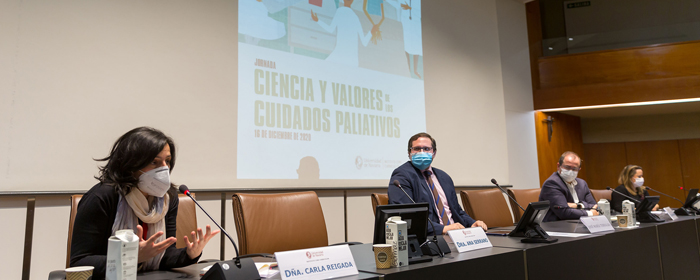NCID Research Workshops: from the effect of lead on the rise in crime to the global fall in the income of the work
Researchers from academic centers such as Princeton, London School of Economics or Stockholm School of Economics presented recent research on Economics and development at the ICS Navarra Center for International Development.

PHOTO: Courtesy
How does the use of lead in gasoline relate to the rise in criminal violence in U.S. cities? Where is the point at which the wealthy are indifferent to evading taxes or paying them? Has the income from work fallen in all industries? To what extent has studying the rain financial aid shed light on the Rwandan genocide?
Researchers from academic centers such as Princeton, London School of Economics or Stockholm School of Economics have presented recent research on these and other topics from Economics and development at seven research workshops organized by the Navarra Center for International Development (NCID) of the Institute for Culture and Society (ICS).
Federico Curci
 Federico Curci, a student at doctorate at the Carlos III University of Madrid, offered some conclusions from his work about the effect of lead on the rise in crime and the urban structure of U.S. cities.
Federico Curci, a student at doctorate at the Carlos III University of Madrid, offered some conclusions from his work about the effect of lead on the rise in crime and the urban structure of U.S. cities.
In his paper 'Flight from urban blight: Lead poisoning, crime and suburbanization' he has shown the effect of violent crime on the decentralization of cities. "Crime increased in the center of cities because that was where there was the highest population density. All the roads went to the center and so that was where there was the most gasoline congestion," he says.
He recalls that in 1996 the use of lead as a fuel additive was banned because of its harmful health effects, which had begun to be investigated in 1965. He assures that after its illegalization, crime slowly decreased in U.S. cities, but the urban structure had already changed. "People didn't go back downtown because they had invested a lot of money in the suburbs," he says.
2. Clara Santamaria
 Clara Santamaría, student of doctorate at the Princeton University (USA), presented the work Small Teams in Big Cities: Inequality, City Size and the Organization of Production.. In it he has tried to explain the causes that influence income inequality, in particular, how "the distribution of people and the organization of production among cities interact with technology to produce income inequalities"..
Clara Santamaría, student of doctorate at the Princeton University (USA), presented the work Small Teams in Big Cities: Inequality, City Size and the Organization of Production.. In it he has tried to explain the causes that influence income inequality, in particular, how "the distribution of people and the organization of production among cities interact with technology to produce income inequalities"..
To this end, he analyzed two policies: the increase in the minimum wage and the subsidy for housing in large cities. "The effects of these policies will be in the short term deadline, when there is no change in technology or in the supply of housing. Maybe in the long term deadline citizens decide to train for more skills, and in that case technological production could change," he concludes.
3. Evelina Bonnier
 The Rwandan Genocide was one of the worst barbarities in recent history. More than 430,000 civilians were killed in 100 days. Why? Evelina Bonnier, a student of doctorate at the Stockholm School of Economics, has shed light on this question in her research Preparing for Genocide: Quasi-Experimental Evidence from Rwanda.
The Rwandan Genocide was one of the worst barbarities in recent history. More than 430,000 civilians were killed in 100 days. Why? Evelina Bonnier, a student of doctorate at the Stockholm School of Economics, has shed light on this question in her research Preparing for Genocide: Quasi-Experimental Evidence from Rwanda.
His study analyzes the potential role in instigating violence against the Tutsi of a mandatory community program that was supposedly intended to ensure political participation and community goal work .
The results suggest that the Umuganda program contributed to an acceptance of the genocide. To investigate the effect of the Umuganda program on the mobilization of Hutu civilians, Bonnier draws a relationship between civilian participation in the violence and Saturdays when heavy rain fell, the reason for the cancellation of Umuganda meetings. The results show that where fewer meetings were held, fewer civilians participated in the killing.
4. Ignacio Campomanes
 Although income inequality has always been a factor that has influenced the setting of the tax system, it should not be the only one to take into account. Ignacio Campomanes, student of doctorate at the University of Minnesota (USA), introduces the mobility and tax evasion as two more factors in their research The Political Economy of Inequality, Mobility and Redistribution.
Although income inequality has always been a factor that has influenced the setting of the tax system, it should not be the only one to take into account. Ignacio Campomanes, student of doctorate at the University of Minnesota (USA), introduces the mobility and tax evasion as two more factors in their research The Political Economy of Inequality, Mobility and Redistribution.
The study sample shows that there is a very positive correlation between high social mobility and wealth redistribution. Thus, it seeks to define a tax system in which taxes are as high as possible to generate a greater redistribution of wealth without discouraging the rich from paying them.
There is a point at which the wealthiest reach the break-even point, where they are indifferent to paying or evading taxes. That is where the highest tax rate can be placed "with which the rich still comply," concludes Campomanes.
5. Luis Díez Catalán
 Is the work rent reduction common to all industries? That is the question that Luis Díez Catalán, a student of doctorate at the University of Minnesotain its work The Labor Share in the Service Economy. His research aims to unravel the reasons that have led to an overall drop in income for work at Economics and to discern whether this is a trend in all industries or only in some.
Is the work rent reduction common to all industries? That is the question that Luis Díez Catalán, a student of doctorate at the University of Minnesotain its work The Labor Share in the Service Economy. His research aims to unravel the reasons that have led to an overall drop in income for work at Economics and to discern whether this is a trend in all industries or only in some.
The study divides Economics between the service sector and the non-service sector. The data shows that the latter has suffered a drop of 14 percentage points since 1980, while the former has increased aggregate income by 6 percentage points to work.
Díez Catalán finds two main reasons to explain this B difference. The first is the fall in the price of capital relative to work. "Technology has made us more productive," he says. As an example, he mentions that computers have made us more effective and, therefore, less staff is required per unit of work. This, together with worker substitutability, "easier and more common in non-service industries," he notes, explains the aggregate reduction and divergence between sectors.
6. Sutanuka Roy
 How do rental incentives affect those who cannot receive them? Sutanuka Roy, a student at doctorate in London School of Economics (UK), addresses this discussion in the case of Indian universities in his research "Disruptive Effects of Preferential Incentives: Evidence from Field experiments in Indian Universities.".
How do rental incentives affect those who cannot receive them? Sutanuka Roy, a student at doctorate in London School of Economics (UK), addresses this discussion in the case of Indian universities in his research "Disruptive Effects of Preferential Incentives: Evidence from Field experiments in Indian Universities.".
In India, citizens are categorized as upper caste or lower caste depending on their family. When it comes to offering scholarships for study, there are two options: to allocate them directly to those with lower income or to base it on academic merit among lower caste citizens. With the first option, 9% of students can benefit from the system, while through the caste system around 50% of the class enters the potential beneficiaries. In total, 82,000 students in India receive a financial scholarship based on their income.
The results show that an income-based approach has a negative effect on the academic results of the entire class. It produces resignation and discouragement among those who do not benefit, which translates into a decrease in cooperation among peers and overall academic results drop. However, in a system based on skill among people in a social subject there are no negative effects.
7. Ada González-Torres
 The Ebola crisis killed 11,310 people in West Africa. Ambiguous messages from public institutions, asking citizens to go to health centers while saying there was no cure for Ebola, led to confusion and lack of trust, which fueled civil violence in the aftermath of the outbreak.
The Ebola crisis killed 11,310 people in West Africa. Ambiguous messages from public institutions, asking citizens to go to health centers while saying there was no cure for Ebola, led to confusion and lack of trust, which fueled civil violence in the aftermath of the outbreak.
Ada Gonzalez-Torres, a student at doctorate at the European University Institute and until recently a visiting professor at the University of California, Berkeley, examines the effect of the epidemic on the increase in violence in her research "Epidemics and Conflict : Evidence from the Ebola outbreak in Western Africa".
Protests, riots and civil violence ensued in the face of insensitivity to local practices, coercive measures and the late and poor distribution of public goods such as Ebola treatment centers. However, the results show that when the violence stopped when sufficient health centers were established. The succession of events resulted in a decrease in citizens' trust in institutions, which weakens the strength of the state.




